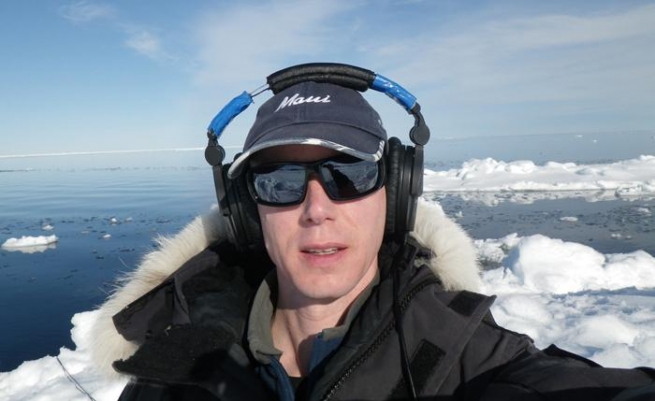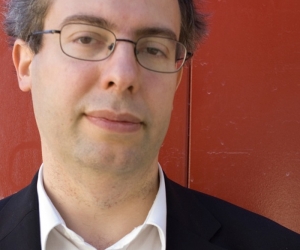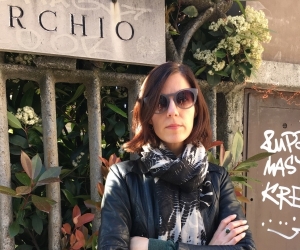
Derek Charke is irresistibly attracted to the North. In 2006 he found himself in the Yukon, dogsledding with the Kronos Quartet. For a composer with a love of the Arctic it doesn’t get better, or more surreal, than this. A few days earlier he had been in a Whitehorse hotel room where Kronos was rehearsing Cercle du Nord III, which they had commissioned from him. Walking into that first rehearsal was a pivotal moment for the thirty-one-year-old composer. After a few days of intense work with the quartet, as well as just hanging out with them in the Arctic, Charke found them to be so open and so intent on seeking out the very heart of his music that he realized they and he were kindred spirits.
The Arctic is by no means the sole inspiration or single subject of Charke’s music. Among the many components that contribute to his individual voice is his persistent refusal to label himself with a single style or language. A winner of the 2012 Juno Award for Classical Composition of The Year for Sepia Fragments, a string quartet commissioned by the St. Lawrence String Quartet, Charke is also an accomplished flutist and a professor of composition. But during time spent studying in North Texas, Buffalo, London, and The Netherlands, and now living in Nova Scotia, Charke has kept returning in body and mind to the Far North.
He first visited the North in 1994 on a road trip with his twin brother, during summer break. The main point of the trip was simply to get away, but something in the vastness and remoteness of the Arctic took hold of him. When he returned to undergraduate studies at the University of North Texas, he carried those impressions with him, along with a subscription to The Inuvik Drum, a weekly newspaper.
After graduating from North Texas and before beginning a masters in flute performance at SUNY in Buffalo, Charke returned to live in the Arctic. This time he could appreciate more of the idiosyncrasies that are often overshadowed by the mythology of the place, and which had become evident when he had read the Inuvik Drum back in Texas. The paper had a regular feature—“like a tabloid has its cover girl page,” he chuckles. “But the Inuvik paper featured the ‘traffic accident of the week.’” Such quirky anomalies of the North—which, after all only, make it more like anywhere else—were gradually becoming a part of his larger, more complex picture of the Arctic. And this only intensified its allure for him.
There were many moments while living in Inuvik when he felt he never wanted to leave. But he also knew that his studies were not done, and if he was to become a professional composer and flutist, he could not stay there. So he applied to study with Louis Andriessen, and received a grant to live and study in The Netherlands. The most valuable thing Charke took away from his work with Andriessen was the confidence to follow his own instincts, and to write what he really wanted. Andriessen taught him the concept of finding the right wrong note. This “extends beyond pitch material itself,” Charke insists. It is a somewhat elusive process through which, in composing, you try to find the idea that clashes in just the right way with the other musical materials that make up the piece. “If you have a pre-compositional plan, you have to introduce the wrong note, or something quirky. This keeps the piece vibrant. As a listener, you never know if what you anticipate is going to fulfill itself. That wrong note might be the Damascus moment in that piece.”
During his trips to the North, Charke had come across Inuit throat singing. Throat singing’s rhythmic complexity-within-simplicity suited his musical language, and the deep, guttural expressiveness of it offered great dramatic promise. It was during his time at SUNY that he finally had the opportunity to join his love of the North with his composing.
“In 2002 we were given an assignment to create short works that would be recorded in the studio. I had written works about the North but had never used sounds or transcriptions from the North. I got together with a colleague, Carter Williams, who played the violin and viola d’amore. And I started to think about what kinds of unusual sounds we could find, and somewhere in the session he started to produce grinding sounds. They reminded me of throat singing. So, together we explored some techniques, and over a few hours discovered a few different ways to produce grinding sounds—especially when using circle bowing—that more closely resembled the sound of throat singing.”
With this Charke had struck upon his own signature techniques and sounds for strings. “I transcribed various throat songs and then created a series of eleven throat songs for string quartet based on these transcriptions.” The following year he created two new works based on the circular-bowing techniques: Cercle du Nord I and his first purely electroacoustic work, Cercle du Nord II, which included some of the original recordings.
In spring of 2004 the Kronos Quartet issued a call for scores for composers. He sent them the score and recordings for the Eleven Throat Song Transcriptions, Cercle du Nord I, and Cercle du Nord II. A year later he received a call from David Harrington, violinist for the Kronos Quartet. He asked Charke to meet him in Waterloo, where Kronos was giving a concert.
“I drove down and met him in an Indian restaurant,” Charke describes. “Over curry he discussed how he had heard this amazing throat singer, Tanya Tagaq, and wanted to find a way to work with her. He said that when he heard the works I submitted for the call he knew this might be a way. He suggested I write a work for Kronos using throat singing and a northern soundscape. After our meeting I decided I better be preemptive about this opportunity. I contacted some people I knew well in Inuvik; I flew to Inuvik, [stayed] for a week, and recorded sounds from around town. I rented a car and drove out on the ice road to Tuktoyaktuk, and recorded more sounds there.”
In this, his first experience of field recording, Charke ran into some difficulties. “From being there, I had always thought it was very quiet,” he says. “My perception of the landscape and the sounds versus the reality of the landscape and the sounds was a very different thing.” When he listened back to the sounds he’d recorded in Inuvik, he realized how much extraneous sound there was. Every town has to run a power generator, so wherever he went, it was impossible to escape that machine’s persistent drone. But the playback also included the sounds of water trucks, which, because there are no underground pipes, deliver to all the homes at least once a day. Then he went to Iqualuit to record ravens and dogs, and encountered not only those noises, but the sounds of skidoos and of kids playing. “These towns are actually quite noisy and busy,” he says. “That was what hit me: just how much miscellaneous noise there was everywhere. And that was one thing I decided to keep in all of the pieces.”
This also speaks to a very individual aspect of Charke’s depiction of the North in sound. He foils the highly dramatic, idealized musical representations with a devilish sense of humour. His discovery and embrace of extraneous sounds fits perfectly with his process of composing. He doesn’t identify the anomalies, the quirks, or the “wrong note” in order to eliminate them, but to discover the musically meaningful ones, the ones that might make the piece work: the right wrong note.
This was illustrated in a talk he gave at the University of Manitoba along with composer and guitarist Tim Brady. Brady commented on an audio example Charke had played of northern kids playing hockey. Brady observed that this could have been recorded anywhere in Canada. Charke responded, “Exactly!” This points to a subtle but consistent undercurrent in Charke’s work. We are all struck, as Charke was, by the Arctic’s mythology, the picture of a vast, unblemished, empty expanse of ice and snow. But reality is not experienced on this mythic level. The recordings could not block out the noise, so noise became a part of the music. Charke also points to the cultural ambiguities that a more idealized treatment of the subject might tune out. “There’s nothing that different about kids growing up in these places versus the rest of Canada,” he insists. “All the younger generation want to be a part of what’s happening everywhere else. And so this whole mythology of what I originally thought of as the North, versus the reality of what it actually is, that’s what I particularly found striking; and it stems back to that first time I went back to Inuvik to start recording the sounds and saw that this is actually the reality of what the North is right now. There’s still this mythology, but they’re in the twenty-first century as much as we are. It was interesting for me to make that connection early on. And then when I’m composing and thinking about the place, that’s something that really comes into my thought process.”
Having a multifaceted appreciation of the North, Charke does not simply paint a descriptive landscape. In spite of using site-specific recordings, some of which evoke imagery, and using cultural references like throat singing, what he composes is not representational. He is true to his word as an avowed writer of absolute music. He uses these referential sounds as pure musical materials, and he molds them, connects them, chisels away at them like a sculptor. In fact, he is prone to compare his method to sculpting—ideas being like clay or stone, which he reshapes until the work is extracted from them. In the wind-blown opening of Kronos-commissioned Cercle du Nord III—the sounds of dogs barking their complaints into the bleak cold air—the listener feels like he or she is being placed in a scene; but after a minute, with the entrance of the quartet, the pictorial clarity of the scene is blown apart by the hacking sound of open strings and blasted away by a throat-song-like locomotive. This is a purely musical event, not part of a programmatic narrative. As the work continues along through Charke’s distinctively dramatic twists and turns, it might suggest here and there that we are situated “somewhere,” but only because the sounds do, after all, come from somewhere, lending themselves to a trompe-d’oreille effect, suggesting a location, and perhaps a narrative.
In 2006 David Harrington met with Charke and reported how happy the quartet was with Cercle du Nord III. Kronos had added Cercle du Nord III to their touring schedule and, over the next two years, they performed it over thirty-five times around the world. Following on this success, the quartet asked him to compose a new work, this time with Tanya Tagaq. This is how Tundra Songs came to be.
Charke admits that Tundra Songs is a more idealized take on the North: the extraneous noise, the sonic grit, which he used in Cercle du Nord III, is missing. “I think you hear the skidoo only once in Tundra Songs,” Charke says. It was partly that there were extra funds to make the recordings for Tundra Songs. This allowed him to actually go out and get away from the human population. The experience changed his perspective on the North yet again. “When you do get away from town, then you do find that idealized landscape. You are in that place.” Inuvik is a busy place—trucks coming in continually on the ice roads, ever expanding oil exploration—as is Iqualuit, the capital of Nunavut. But a place like Pond Inlet, where he travelled most recently to make pristine recordings of the environment, is much different; and his experience there, camping on the edge of the ice floe, presented him with the mythic North. “Tundra Songs is a very personal work for me,” says Charke. “Even this summer, when I was in Pond Inlet, I didn’t want to return south again. I know this is a strange thing, but I really do like being in the North, and the Far North in particular. There’s something about the location, the people, and the culture that resonates with me. Tundra Songs, I believe, expresses my own emotions of being in that place.”
It is clear that his experiences with the Kronos Quartet in Whitehorse marked a turning point for Derek Charke, but Tanya Tagaq made a significant impact of her own. Meeting and hearing her, and beginning a sustained and growing musical encounter with her, has drawn the throat-singing element into his music. Tagaq’s performances are commonly described as “elemental.” This points to an organic relationship between the Arctic (in all its aspects, real and mythic, comic and tragic) and the music she makes. In performance, Tagaq embodies the sublime extremes of the glorious and the guttural.
There are differences and similarities between Charke the composer and Tagaq the throat singer that make for a powerful combination. She comes from an oral tradition, and famously does not read music: she is an improviser. He is steeped in musical literacy, but has spent years working out methods to allow for aleatoric and improvisatory elements in his music. Tagaq not only has the authentic experience of growing up in the Far North, but she has the ordinary, shamanistic voice that takes possession of her audience in a way that allows them a direct experience of a world that no language can describe.
Charke and Tagaq have just finished co-composing Nanook of the North, a collaborative piece written for voice, violin, percussion, and soundscape, to accompany the 1922 Silent Film by Robert J. Flaherty. In the soundscape, Charke uses vocal samples of Tagaq along with his usual collection of field recordings from the North, as well as sounds that he produced by— among other tricks—rubbing pieces of styrofoam together. The film itself has been controversial because of staged scenes and faked anachronisms that some have claimed are historically and culturally deceptive in a film that bills itself as a documentary.
Working on Nanook has taken the working relationship between Charke and Tagaq to yet another level. To create the score, he worked with two recordings of Tagaq. On the first recording, Tagaq improvises, responding to the sixty-five-minute film. The second track, recorded the day after the first, is an intricate elaboration—melodically, rhythmically, and metrically—of the first track. Charke uses Tagaq’s recorded improvisations both as musical material and as a structural template. Often Charke likes to think of his own process as a single thread from beginning to end. In this case, Tagaq’s performance and the film itself provide the single thread.
One unmistakable feature of throat singing is its relentless in-and-out rhythm, but there is nothing simple about Tagaq’s approach to repetition. Charke spent three days working on five minutes of the recorded Nanook improvisation, trying to line up all the musical material with the multilayered interplay of rhythmic, melodic, and metric development between her two improvised tracks. As she plays with the pulse, she also creates a dialogue between background, middle-ground, and foreground melodic material through the use of different registers. All the while, she gradually changes the tempo over time in a way that, if notated, is exactly mensurally proportional. Her sense of rhythm and tempo is flawless. “You could set a metronome to what she’s doing,” says Charke, “and she’s not using a metronome.” He delights in the labour of nailing down these few minutes of music so meticulously, in order to make something very complex and intricate sound simple and organic. “It’s a joy to work with this [five-minute section of Tagaq’s recording] and put a rhythmic track and other things to it as it is proportionally getting faster and slowing down over an incremental period of time.
Improvisation is itself a challenging and compelling component in the score for Nanook, as it has been throughout Charke’s musical relationship with the non-note-reading Tagaq. It makes sense that his experience writing jazz charts during his high school days allows him some ease in conceiving a score like Nanook, where improvised sections must be indicated by various written means, and must clarify the intended rhythmic and harmonic relationships with the soundscape for performance by the throat singer, as well as the two musicians, Jean Martin and Jesse Zubot, who will play with her on this project. So Charke’s long history and interest with the representational and practical complexities of score writing serves him well in translating his diverse musical language for musicians from all sorts of backgrounds and who use different modes of musical communication.
Charke’s relationship with the North is now as complicated as ever. “The last few years I’ve made a deliberate attempt to make things not about the North,” he declares. “It does shape who I am, but it’s not all I am interested in.” For his Concerto for String Quartet and Orchestra he had no intention of making any kind of reference to the Arctic, but as he was composing the piece’s ending, it became evident that it called for the use of sounds he had recorded in Pond Inlet. In spite of the many musical choices offered by his diverse musical language, he had no choice. As ever, he had to stay true to his musical materials, allowing them to take the form and the structure they themselves demanded.
Our environment expresses itself through sound. Derek Charke is hooked on sound. The Arctic speaks to him, sings to him, through sound. He captures those sounds in field recordings, and, through his music, allows the North to speak to his audience. “I love to work with these sounds. I love to hear them. And I hope it comes across in the music that I really care.”
Audio: Nanook of the North (Excerpt from the soundscape, 2012). Composed by: Tanya Tagaq and Derek Charke. Image: Derek Charke, courtesy of the artist.


